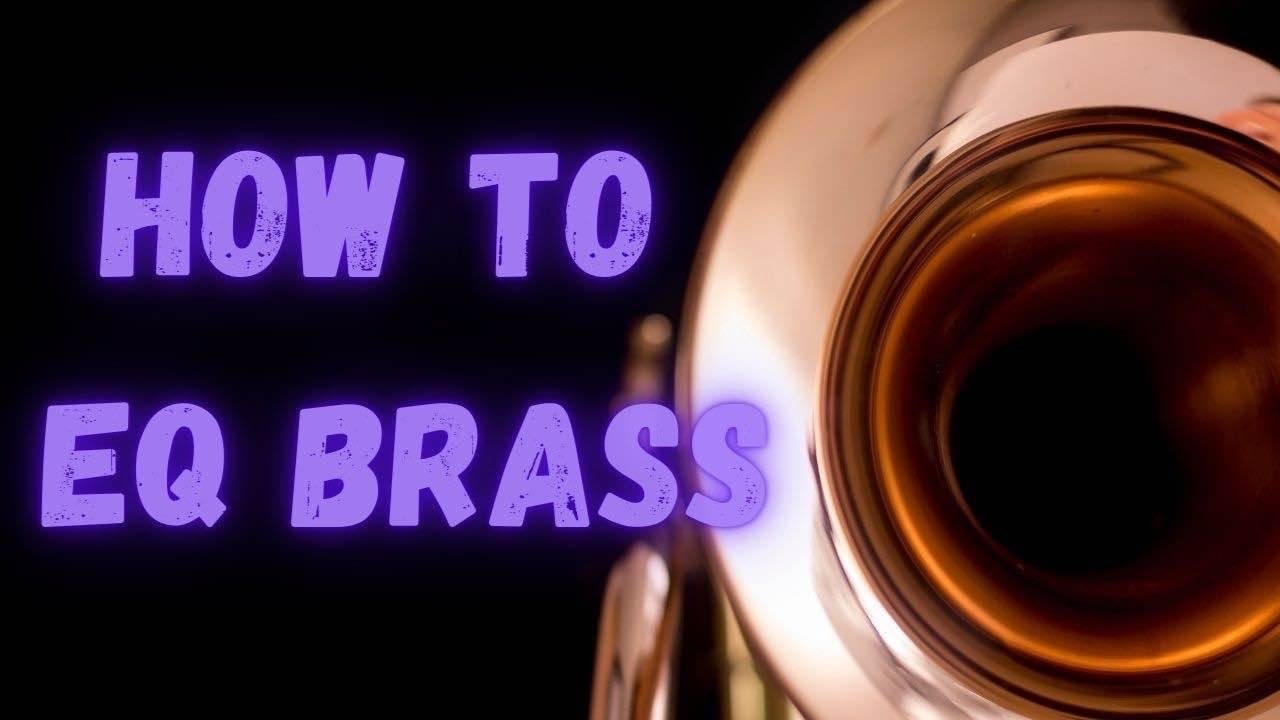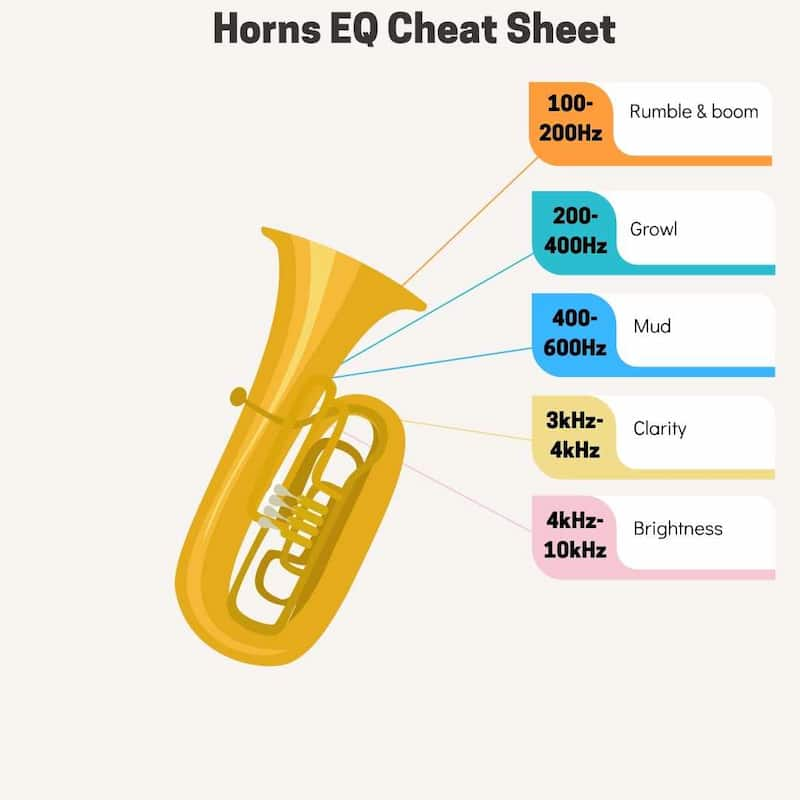How to EQ Brass

Learning how to EQ brass can be quite difficult, as the range of brass instruments is fairly wide. Plus, brass instruments are just as tonally dynamic as the human voice, giving you different tonalities to consider as they move throughout their range.
Beyond all of that, if you’re working with a poorly recorded brass instrument, you may be wondering how you can get rid of harshness, boominess, or jarring resonances.
Luckily, you’ve come to the right place.
Whether you’re dealing with an Earth Wind & Fire-style, brass-driven tune, or a Hans Zimmer-style orchestral composition, we’re going to take you through all you need to know about EQ for brass instruments.
And at the end of this article, you'll find a free Brass EQ Cheat Sheet that you can right click to download!
Note: this article may contain affiliate links, which mean that I receive a commission for any purchases you make, at no added cost to you.
Unique Issues With EQing Brass
As we said before, one of the most difficult things about EQing brass is that brass instruments are tonally dynamic. For example, one could play a note on a trombone very softly and get a warm, round tone that might need a little bit of an upper-mid bump to cut through. However, that same note played loudly could make that upper-mid bump a bit too harsh for the mix.
While you often need to think dynamically when it comes to EQing brass, it’s important to have a fundamental understanding of where certain tones lie in the frequency range. To help you get started, we’re going to take you through all you need to know about EQing each popular brass instrument.
How To EQ Tuba
In a traditional brass section, the tuba takes on the role of the bass. If you’re dealing with a traditional mix, it’s important to leave the low-end in. Many amateur engineers make the mistake of high-passing every instrument because someone online told them to do so. However, if the makeup of that instrument requires low-end frequencies, you’d be doing your mix a dis-service by cutting them out.
However, if you’re dealing with a tuba in the context of a modern track with drums and bass, it is a good idea to roll off the low-end so that you can still hear the notes without the boominess.
Speaking of boominess, tuba can get pretty boomy in the 100-200Hz range. If you feel your mix being swallowed up every time the tube player hits a note, it’s best to start your hunt here.
As for the top end, you can usually use a low-pass to get rid of a lot of it without any harm. The tuba tops out around 3kHz or lower. Yes, there is moving air up there that can be helpful in a sparse mix, though it’s usually a good idea to get rid of any unnecessary high frequencies to make room for the higher brass instruments, such as the trumpet and trombone.
How To EQ Trumpet
The trumpet plays a lead role in most brass sections. You want your trumpet to soar above everything else, especially during a solo section.
Because it’s usually a good idea to approach EQ from a subtractive standpoint before attempting to accentuate anything, we like to start by rolling off any unnecessary low frequencies. If you’re dealing with a dense mix, you can usually roll the high-pass filter up to above 150-200Hz without impacting the natural sound of the trumpet.
However, if you’re dealing with a Miles Davis-style solo trumpet, it’s best to leave that low-end in for added warmth.
Next, if your trumpet recording sounds harsh (which is not uncommon in home recordings), it’s a good idea to look between the 1kHz and 3kHz range to control your trumpet. In the case that some notes sound harsh while others don’t, you can use dynamic EQ to attenuate the notes that splat while keeping the other present and intact.
We often want our trumpets to be bright, which is why it’s a good idea to look between the 4kHz to 10kHz range and use a high shelf to give them a bit of air. Take caution, however, as it is easy to blow someone’s head off by boosting your trumpets too high in this range.

How to EQ Trombone
The trombone holds down the mid-range and low mid-range in a traditional horn section. More often than not, you don’t need any of the low-end in your trombone EQ, as it’ll mask the tuba and other low-end instruments in your mix. Using a shallow high-pass filter, you can usually cut up to around 70-80Hz without destroying the natural sound of the instrument.
It can be a good idea to take your high-pass filter way up to where you hear it and start slowly bringing it back down to where it sounds full again.
If the trombonist is playing a lot of low notes in the arrangement, it can be a good idea to try and accentuate those notes. To do so, you can look for additional beef around 100 to 300Hz and boost with a wide Q value. We recommend keeping your boost about 4dB or below to maintain a natural sound.
Lastly, you might want to get rid of annoying, splatty sounds, especially if the trombonist plays high notes in the arrangement. We’ll often boost 1 to 5kHz and sweep around to determine where the ugly frequency is coming from. Once we know where it’s at, we can get rid of it with a slight few-dB cut.
How to EQ French Horns
The french horn and the trombone are similar in many ways. However, the french horn typically lies slightly below the french horn in the frequency range, meaning it’s best to approach it with a lower mindset.
You can still gently roll off anything below about 80Hz without interfering with the natural sound, though you probably won’t have to deal with as many splatty notes in the upper mid-range due to the tonality of the instrument.
If anything, you can usually get away with a low-pass filter, as the french horn tops off at around 7kHz.
How to EQ Synth Brass
Synth brass comes in all shapes and sizes, so the EQ possibilities are near limitless. However, if we’re going to generalize and come up with some places where you can begin to look, here are our thoughts.
For starters, synth brass can get pretty muddy in the mid-range around 400-600Hz. If your synth brass feels like it’s clouding your mix, you can gently cut it here. However, we find that VST synth brass can usually use a boost here to give it additional warmth.
If your synth brass is lacking clarity, we recommend looking in the 3kHz to 4kHz range and applying a small, wide boost.

How to EQ Horn Sections
When dealing with an entire brass section, you’ll usually find a ton of low-end buildup around 100 to 200Hz that you can attenuate. Rarely will a horn section need to function as a bass instrument, which is why you can gently roll it off with a high-pass filter up to around 60Hz and deal with any boominess as needed.
Horn sections that lack brightness can typically use a bit of love in the 4kHz to 10kHz region. We recommend using an analog-style EQ when boosting top-end on brass, as digital EQs often make brass sound harsh and brittle, especially with large top-end boosts.
What do you think? Is this how you approach EQing brass or do you have a different strategy? Let me know your thoughts in the comments, and if you have any questions, asking them below! I respond to every comment.
How to use EQ Guides
To help you get the most out of your EQ plugins, we've put together these detailed guides to teach you how to use EQ on some of the most popular instruments.
- How to Mix with EQ
- Tips for EQing piano
- Electric guitar EQ tips
- How to EQ acoustic guitar
- How to EQ bass guitar
- How to EQ drums
- How to EQ vocals
- How to EQ woodwinds
- How to EQ strings
- How to Use Mid-Side EQ
- 3 Powerful Ways to Use Dynamic EQ
- How to EQ Loops
- How to EQ Reverb
- How to EQ Percussion
From a Frustrated Producer in a Ragtag Bedroom Studio to Major Placements on TV Earning $1,000s!
My name is Evan, and I've been making music since around 3rd grade. I'm from San Diego, California, but I've lived in Washington, DC for the last 20 years.
While I still have a full-time day job, I have created systems that have allowed me to produce dozens of songs a year in my spare time.
My songs have been on Netflix, TV shows like the 90 Day Fiance, an award-winning indie film, and NPR’s “All Thing Considered.” They've also been streamed millions of times.
In addition to being a music producer, I am passionate about teaching people how they can make professional-sounding music and earn money licensing it, all in their spare time.
Thousands of musicians, like yourself, have trusted me to guide their musical journey. My YouTube videos have been watched nearly a million times. And my story has been in Forbes, Side Hustle Nation, and the Side Hustle School.






